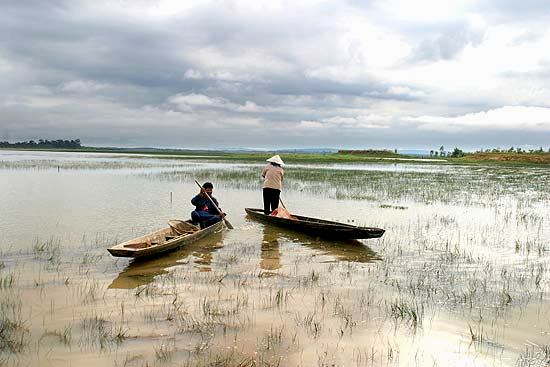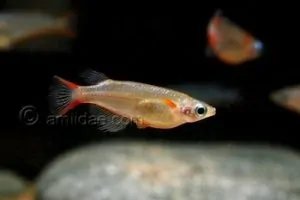Boraras micros
Boraras micros was first described in 1993 by Kottelat and Vidthayanon. The genus name is an anagram for the genus Rasbora, this name has been chosen because the difference between Boraras and Rasbora consists of the inverted ratio between the fin rays in the caudal- and pelvic fins. Micros is a reference to the tiny size of this fish.
Ze maken onderdeel uit van de familie Danionidae ofwel de Danios. Het geslacht Boraras omvat momenteel 6 soorten, de familie Danionidae heeft zo’n 40 geslachten en ongeveer 367 soorten.
Description
The first thing you will notice on Boraras micros is that they are tiny. Adult specimens will reach a total length of around 1 to 2 centimeters. It is a small fish that will do very well in a small aquarium together with some other small aquatic animals.

They have 3 striking black dots, one on their side, one on the base of their anal fin, and one on their caudal fin. Their head and abdomen have a white ground color but the rest is fairly translucent. From the south of Thailand, a more red variety is known called Boraras cf. micros because this is most likely a new species. Boraras micros is hard to get by in the aquarium trade. Sometimes they offer Boraras micros Red or some similar fantasy name, usually, these are Boraras brigittae or Boraras maculatus.
You can see the difference between males and females once they are mature. Females grow a little bigger than males and their belly is more rounded.
Biotope
Boraras micros habitat is limited to some swampy areas in the north east of Thailand. They inhabit shallow waters, marshes, rice fields, and floodplains. All these areas are characterized by dense vegetation.

Diet
Despite its small size, it is still a predator. They hunt microscopic animals such as small insects, worms, invertebrates, and zooplankton.
In the aquarium, you can feed them with flake food, but alternate this with live or frozen food to keep them healthy. Think of daphnia and brine shrimp.
The Aquarium
The females, young and non-dominant males usually swim together and form a school. The dominant males occupy their own territory in which they want to entice females to mate. They engage in mock fights with the other males, standing opposite each other or dancing around each other with their fins spread wide.
Despite their small size, they need a relatively spacious aquarium because you need at least 8 to 10 specimens to make them feel comfortable. The larger the group, the more natural the behavior. Therefore, maintain a minimum size for the aquarium of about 45 x 30 centimeters, but preferably more.
Because it is such a small fish, it is difficult to combine with other larger species and they are quickly seen as food. Suitable species are, for example, Microdevario, Sundadanio, small Corydoras and, for example, Otocinclus. A number of shrimps such as Caridina or Neocaridina can also be kept together.
Aquarium decoration
Furnish the aquarium with lots of plants with some open swimming space in the middle. Floating plants and, for example, some roots that stick out from above the water give the aquarium a natural look and dim the light a bit so that they feel a bit safer.
The filtering does not have to provide too much flow. Boraras micros come from very slowly flowing or stagnant water, so too much current can exhaust them. A Hamburger Mat Filter (HMF) is an excellent choice for this species. This filter produces little current and the fish can search for microscopic food particles on the filter surface.
Boraras micros are sensitive to fluctuations in water quality, so change regularly and ensure that there are as few fluctuations in temperature and water composition as possible.
Breeding Boraras micros
In a densely planted aquarium without too many predators, breeding occurs naturally. The male attracts a female to his territory by spreading his fins and luring her with vibrating movements. They swim around each other a few times and with a vibration the female lays 1 or 2 eggs that are immediately fertilized by the male. This can happen under a large leaf or simply between some Java moss. If you don’t pay attention, you’ve already missed the whole process.
Once the eggs have been laid, the parents no longer care about them. A female only lays 1 to 2 eggs at a time but continues to do so continuously. This is about 6 to 12 eggs per week. The young hatch after about 2 days. Occasionally some young fish might survive in the dense vegetation.
Special breeding tank
If you want to keep more fry, you can install specially equipped small aquariums of about 10 to 15 liters. Decorate them with, for example, artificial grass or small marbles on the bottom. Place a large tuft of Java moss above that, filling at least half of the aquarium. Eggs that fall through the Java moss end up between the marbles where the parents can no longer reach them.
Keep the temperature at 26 to 28 degrees Celsius and pH of 6.0 to 7.0. Filtration is not really necessary, but a small air filter can do no harm. Fill the breeding aquarium with water from the large aquarium so that the transition to the breeding aquarium is as small as possible.
Now add 2 to 3 pairs of adult Boraras micros and leave them in the aquarium for a few days. The parents will now lay a few eggs every day. After a few days, remove the parents because the eggs hatch after 2 days.
The young live on their egg yolk sac for another day and can then be fed with microscopic food such as slipper animals or infusoria. After a week to ten days, you can switch to slightly larger food such as freshly hatched brine shrimp or microworms.
The young are also very sensitive to changes in water composition. Wait at least 2 weeks before changing small amounts of water in the breeding aquarium. Even then, change very small amounts at a time.
Conclusion
If you are willing to provide the Boraras micros with a suitable environment, it is a very nice little schooling fish. They are less suitable for keeping in a community aquarium. I would only recommend this species for the more advanced aquarium keeper.
Video
Author
John de Lange
Copyright images
Choy Heng Wah
Nonn Panitvong – Siamensis.org
Hung Jou Chen
Resources
Seriouslyfish.com
TFHmagazine.com
Practicalfishkeeping.co.uk
Fishbase.org
Acquariofiliaconsapevole.it
Aquabase.org
Aquaportail.com

















Reviews
There are no reviews yet.